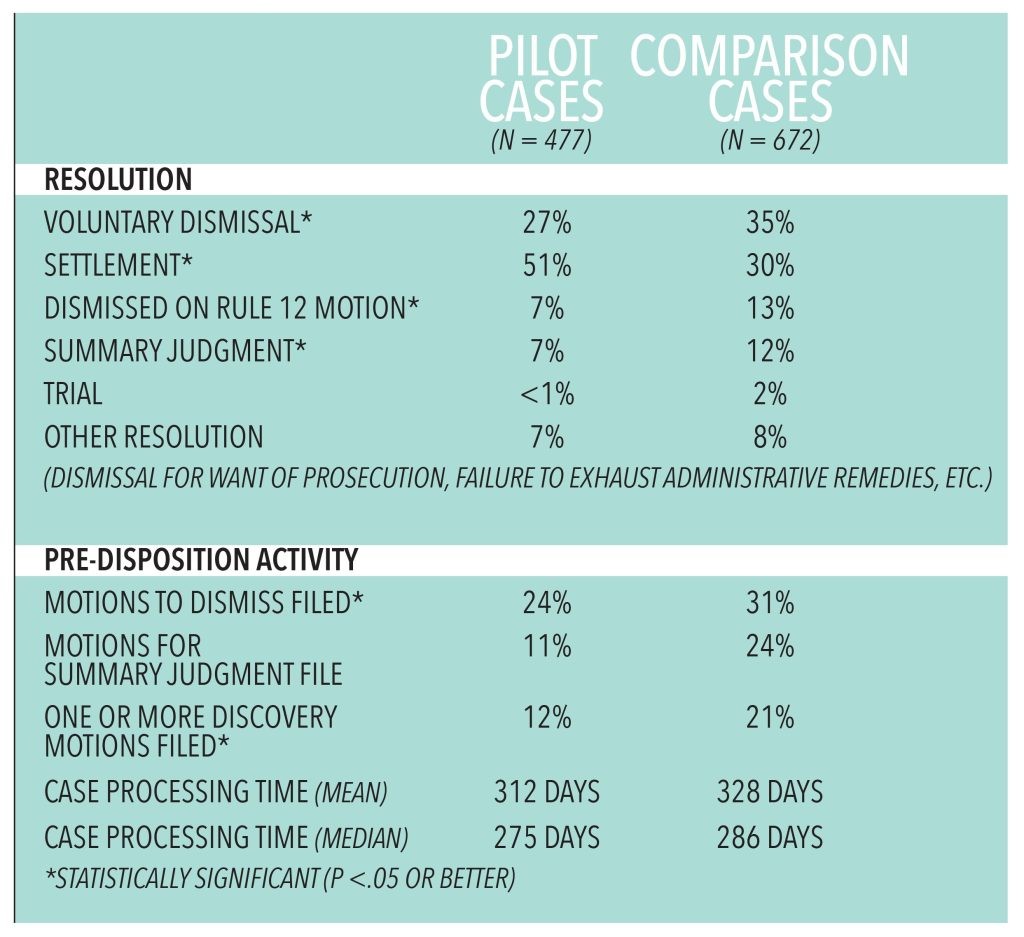Pilot Project for Discovery Protocols for Employment Cases Alleging Diverse Action
by Emery G. Lee III and Jason A. Cantone
Vol. 100 No. 1 (2016) | 100 Years of Judicature | Download PDF Version of Article
In November 2015, the Federal Judicial Center (FJC) reported to the Judicial Conference Advisory Committee on Civil Rules on a pilot project designed to streamline litigation by using pattern discovery in similar cases. The project involved more than 50 federal district judges who adopted the protocols and almost 500 cases in 10 districts since the project began in late 2011.
The idea of streamlining litigation — reducing costs and delays — through the use of pattern discovery in similar cases was discussed at the 2010 Civil Litigation Review conference held at Duke Law School. As an outgrowth of those discussions, a group of plaintiff and defendant attorneys — all highly experienced in employment discrimination cases — developed a pattern discovery protocol for use in adverse action employment discrimination cases in cooperation with the Institute for the Advancement of the American Legal System (IAALS).
The protocol was implemented in 500 pilot cases in 10 districts. Researchers compared those cases to randomly sampled terminated employment discrimination cases from approximately the same filing cohorts. Information was collected on case processing times, case outcomes, and motions activity in the pilot and comparison cases.
The study found no statistically significant difference in case-processing times between the pilot cases and comparison cases, and the pilot cases did not reach settlement earlier than the comparison cases.
On the other hand, although the nature of private settlements makes it difficult to determine conclusively, it appears that pilot cases were more likely to settle than comparison cases. (Many, if not most, voluntary dismissals — stipulated in most cases — are likely settlements, but a case was only coded as settled if there was some positive indication on the docket or in the stipulation that the parties reached a settlement.) The most common case outcome for pilot cases (N=477) was settlement, observed in 51 percent of cases. The second-most common outcome for pilot cases was voluntary dismissal, observed in 27 percent of cases.
The most common case outcome for comparison cases (N=672) was voluntary dismissal, observed in 35 percent of the cases. Settlement was the second-most common outcome, at 30 percent. The maximum, combined estimate for the settlement rate in the pilot cases is 78 percent and 65 percent in the comparison cases.
The lower settlement rate for comparison cases corresponds with comparison cases being almost twice as likely to be dismissed on a Rule 12 motion (13 percent of all case outcomes) or resolved through summary judgment (12 percent) than pilot cases, which were dismissed on a Rule 12 motion 7 percent of the time and resolved by summary judgment 7 percent of the time. These two outcomes account for fully a quarter of dispositions in comparison cases but only about an eighth of dispositions in pilot cases.
“It appears that pilot cases were more likely to settle than comparison cases.”
Before disposition, pilot cases had generally less motions activity than comparison cases. Both motions to dismiss and motions for summary judgment were less likely to be filed in pilot cases. The same was true for discovery motions (motions for protective orders and motions to compel discovery, including motions to compel initial disclosures required under the pilot). One or more discovery motions were filed in 21 percent of the comparison cases, compared to only 12 percent of the pilot cases. The average number of discovery motions filed in pilot cases was about half the average number filed in comparison cases. That difference is statistically significant (p < .001). Cases with more than two discovery motions were quite rare. Three or more discovery motions were observed in about 1 percent of pilot cases and 2 percent of comparison cases.
Some of the findings summarized here are consistent with the hypothesis that the pattern discovery required under the pilot was effective in reducing discovery disputes and perhaps reducing costs — assuming, that is, that fewer motions correspond with lower costs overall. (Costs are difficult to measure directly.) The findings are also consistent with the hypothesis that the pilot cases were more likely to result in settlement, although not necessarily an earlier settlement.
Two caveats are in order. First, while the initial disclosures required by the pilot were docketed in some cases, this does not appear to be standard practice. Thus, it is impossible to determine how often the parties in the pilot cases actually complied with the discovery protocols and exchanged the required initial disclosures. In fact, in some cases, it was relatively clear that the parties delayed the exchange while engaging in settlement efforts.
Second, the report makes no claim that the only factor differing between the pilot and comparison cases was the pattern discovery in the former. Cases were not randomly assigned to be pilot or comparison cases. Individual judges’ practices vary, and judges inclined to adopt new discovery procedures may vary in some systematic fashion from judges who decline to do so. Individual districts’ local rules and procedures also vary. As a result, one must be cautious before concluding that the pilot program is responsible for the differences in outcomes.
— Emery G. Lee and Jason A. Cantone are research associates at the Federal Judicial Center


